Ultimate Beef Burger Recipe Guide for Flavorful Meals
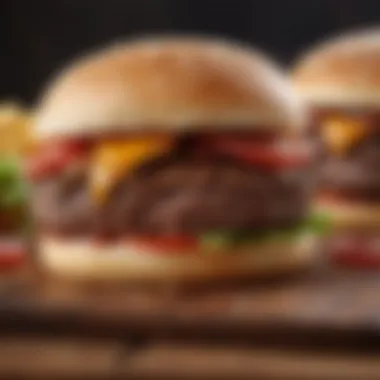
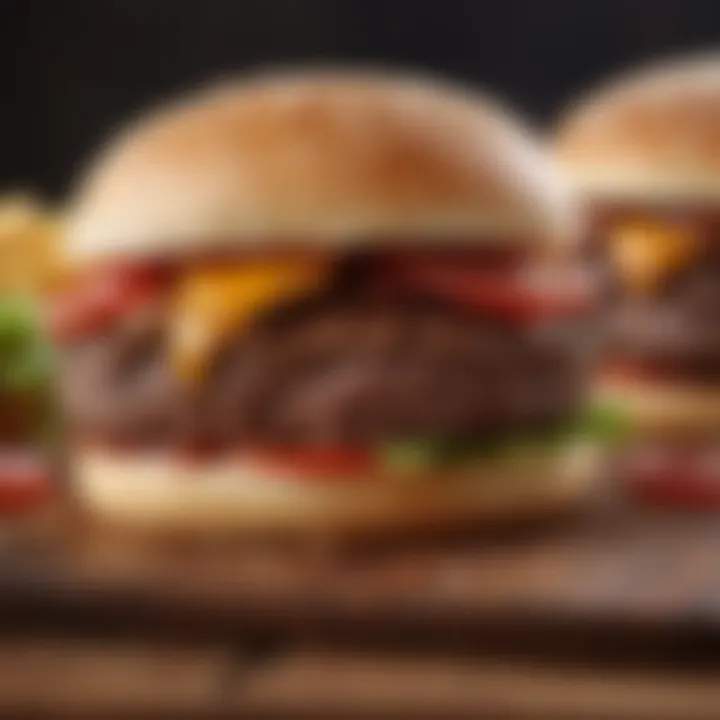
Intro
Creating the perfect beef burger is more than just cooking meat on a grill. Ultimately, it is about understanding the elements that go into making a satisfying and flavorsome meal. This guide aims to serve those who value efficiency yet want to retain taste. Here, we cover indgredient selection, prepping techniques, cooking methods, and various serving ideas to create cheerful dining experiences any day of the week.
Recipe Overview
- Name: The Ultimate Beef Burger
- Yield: 4 Servings
- Preparation time: 15 minutes
- Cooking time: 10 minutes
- Difficulty level: Easy
- Main Ingredients:
- Ground beef (80/20 is ideal for juiciness)
- Hamburger buns
- Cheese (optional)
- Lettuce, tomato, onion
- Condiments (such as ketchup, mustard, and mayo)
Step-by-Step Instructions
- Prep the ingredients:
Start with ground beef. Form it into patties with your hands, ensuring not to compact the meat too much. A thickness between ¾ inch and 1 inch is recommended. - Season the patties:
Sprinkle salt and pepper lightly on both sides of the patties. For a different flavor, consider adding garlic powder or smoked paprika. - Cooking the burgers:
Preheat a skillet or grill. For a grill, high heat will produce a nice sear. On the stove, medium-high heat will do well. Cooking for about 4-5 minutes on one side and flipping it for another 3-4 will achieve medium doneness. - Add cheese:
Melt cheese on top of the burgers nearly a minute before removing from heat. - Toast the buns:
During the last couple of minutes the burgers are cooking, place the buns on a separate part of the grill or pan until they are lightly golden. - Assemble:
Place the beef patty on the bottom bun, layer with seasoned lettuce, a slice of tomato, and onion. Finally, drizzle with condiments before topping with the bun.
Nutritional Information
- Calories per portion: Approximately 400-450 calories (varies with toppings)
- Protein: Approximately 25 grams
- Fat: 30 grams
- Carbohydrates: 37 grams
Highlights: This offering has a significant amount of protein along with vitamins from vegetables.
Quick Cooking Tips
- Using an air fryer makes it possible to cook the patties while reducing the fat without losing flavor.
- Multitask effectively. Prepare your veggies while the burgers cook, making the process smoother.
- For a quicker burger, you can ensure that the pre-formed patties were previously frozen. Cooking time might vary slightly.
Related Recipes & Variations
- Explore turkey replacement for healthier option in terms of fat.
- Veggie burger option for those seeking alternatives, consider black beans mixed with spices and oats.
- Pair with sides like homemade sweet potato fries or coleslaw for a complete meal.
Engaging with the nuances of burger artistry not only ensures satisfaction but brings out the relational element of sharing a meal with friends and loved ones. Creating only from your perfect taste remains essential.
Preamble to Beef Burgers
Beef burgers hold a special place in the world of cuisine. Their ease of preparation, coupled with the versatility of flavors they can accommodate, makes them a favorite among many. This introduction aims to lay the foundation for understanding the characteristics and significance of beef burgers. In the following sections, we will explore their appeal and cultural impact.
The Appeal of Beef Burgers
The allure of beef burgers lies in their simple yet satisfying nature. They can be tailored to meet various preferences and dietary requirements. From the richness of the meat to the choice of toppings, the beef burger can take on numerous identities.
- Customizable Options: One significant aspect is the ability to modify every component. Diners can choose how they want their burger cooked, the type of beef, and a myriad of toppings. This customization not only enhances personal satisfaction but also allows for creativity in the kitchen.
- Flavor Combinations: The diverse taste profiles that one can create through sauces, seasonings, and fresh ingredients further elevate the humble burger into a gourmet experience.
With such attributes, beef burgers remain engaging for both home cooks and professional chefs alike.
Cultural Significance
Interestingly, the historical footprint of beef burgers extends beyond mere nutrition. They symbolize comfort food and social gatherings.
- A Shared Experience: In many cultures, sharing a meal of beef burgers can foster bonds among family and friends. Gatherings or barbecues often see these burgers grilling away, serving as focal points of celebration.
Essential Ingredients
The foundation of an excellent beef burger lies in its essential ingredients. Choosing high-quality ingredients impacts the final flavor and texture immensely. From beef selections to buns and toppings, every element plays a role in the overall experience. These choices also empower individuals to create burgers tailored to their specific preferences.
Choosing the Right Beef
Beef is the central component of any burger. Selecting the appropriate type is crucial for achieving the desired taste and texture. Each cut of beef has its unique characteristics that can elevate or diminish the burger experience.
Different Cuts of Beef
When it comes to beef, various cuts have distinct flavors and textures. Cuts such as chuck, sirloin, and brisket offer different mouthfeels and richness. Chuck is a popular choice due to its perfect balance of meat and fat, giving a juicy result. Sirloin, while leaner, can add a rich flavor profile. Brisket, on the other hand, has deeper flavors and works well when combined with other cuts.
The beneficial choice of using chuck lies in its fat content, which enhances juiciness. It generally checks both flavor and tenderness boxes very well. However, it is essential to understand the potential draw of lean cuts, as those may not deliver the level of succulence that comes from a higher fat content burger. Hence, each cut should be explored depending on personal muscular taste preferences and dietary choices.
Understanding Fat Content
Understanding fat content is vital when preparing beef burgers. Generally, beef containing about 20% fat creates a juicy burger. Lower fat options can lead to dryness unless other methods are employed. Fat is the component that not only contributes to the flavor but also to the overall texture.
The Trim quality is also important as lean beef can lead to a dry mouthfeel, often lackluster in taste. Thus, having some fat enhances the burger and infuses it with taste while cooking. Choosing the right fat percentage allows for achieving desired juiciness without compromising health goals.


Seasoning and Flavoring
Seasoning and flavoring your burger properly is equally important as selecting quality beef. The right seasonings act as the flavor enhancer, highlighting the natural taste of the meat.
Basic Seasonings
Basic seasonings like salt and pepper have a significant impact and should be considered first. Salt can draw out moisture, which concentrates the flavor. Just remember, coarse salt often brings an added texture, while fine salt mixes readily into the meat.
Using Sea salt or kosher salt adds a depth that graduates the burger's tasting. Ground black pepper, though simple, brings warmth and a slight kick. When combined properly, these basic seasonings offer a straightforward framework that provides the vital flavor base for the burger patty.
Herbs and Spices
Incorporating herbs and spices can elevate burgers even further. Fresh or dried herbs such as parsley, cilantro, or basil enhance flavor complexities. They enrich the burger, providing distinctive freshness.
More robust spices like cumin or smoked paprika introduce warmth and depth. They add versatile flavor styles that appeal to diverse preferences. However, it is important to exercise restraint—overdoing herbs can clash or mask the meat's natural flavor.
Bun Selection
Selecting the right bun is essential, as it's the bread that completes the burger experience. Different buns enhance flavor and texture in their own unique ways while contributing to the general mouthfeel of the dish.
Types of Buns
From soft brioche to customizable whole-grain or gluten-free options, the world of burger buns is broad. Brioche’s buttery flavor works well by complementing a juicy burger nicely. Meanwhile, more substantial choices like pretzel buns boast a denser texture. These can provide an exciting resistance to bites, giving another layer of enjoyment during consumption.
On the flip side, lower-quality buns may become soggy due to the burger’s juices. This makes the selection of a properly structured bun crucial in preservation of texture and stimulation during the full burger eating experience.
Gluing Ingredients
Gluing ingredients are another focus for burger creativity. Ingredients like mayonnaise or mustard help hold toppings vertically by keeping them intact on the burger. Such substances also elevate the general flavor experience with a necessary zing.
The key characteristic here is that they must balance flavors to compliment without overpowering other essentials in a burger build. By applying an adequate layering approach with such gluing options, a perfect bite of overwhelmingly inclusive tastes can manifest.
Toppings and Add-ons
Equally essential to the construction of an ideal burger, toppings and add-ons contribute distinct textures and flavors, enhancing the overall meal.
Classic Toppings
Classic toppings like lettuce, tomato, onions, and pickles are staples that can complete any beef burger by adding freshness and crunch to every bite. Each ingredient adds unique textures; crisp lettuce along with juicy tomato delivers the freshness necessary to counter the richness of the beef.
While these toppings boast simplicity, going fresh ensures the ideal and delightful experience, whilst preserving nutrients in the balance. Their benefit proves clear: the changing of flavors readily contributes without overwhelming nor dominating primary notes of tangible beef notes.
Unique Flavor Profiles
Unique flavor profiles are best approached from a more assemblage nature. Ingredients such as jalapeños, avocado, special sauces, or gourmet cheeses diversify standard compositions. These toppings and poor-profits hinge tremendously on personal flavors. However, enbobbed carefully they can arrange dazzling just beyond what initially antagonist on a common burger scheme/brand.
Defining blending layers within unique flavors gives one's health tribute an exceptional experience. Additionally, elevated cheeseburger qualities encounter mixed cheeses cleverly incorporated into flavorful depth helping to rebalance or even transform raw presentations.
Don't forget to gather insightful ideas through exploration and experimentation. Try including unexpected toppings as a creative measure or catering to original preferences might unveil a personal savory nugget. Ne're limit if you don't succumb to astuteness!
Each ingredient contributes to the entirety of flavors and experiences for beef burgers. Without mindful selections, the holistic journey becomes stressed and potentially uninspired.
Preparation Techniques
Preparation techniques are critical in making a perfect beef burger. They lay down the foundation for flavor, texture, and overall eating experience. Good preparation ensures consistency and ensures that burgers remain moist during cooking. Understanding how to properly prepare a burger can make the difference between just an ordinary meal and something memorable.
Forming the Patties
A critical aspect in burger preparation is the patty forming. The way the patties are created serves as a base for cooking techniques and final taste. The two main areas of focus are size and thickness considerations and handling techniques.
Size and Thickness Considerations
The size and thickness of the patty greatly influence cooking times and the flavor distribution. Typical burger patties range from a quarter-pound up to half a pound. A patty thicker than one inch may not cook through by the time the outer layer is browned. Thinner patties cook faster and can form excellent browning.
Choosing a moderate thickness, around ¾ inches, is often viewed as a good balance. This allows for proper cooking without losing juiciness. Burgers should ideally be slightly larger than the bun as they will shrink during cooking.
Advantages of considering size and thickness include:
- Optimal cooking times.
- Good flavor distribution.
- Controlled juiciness.
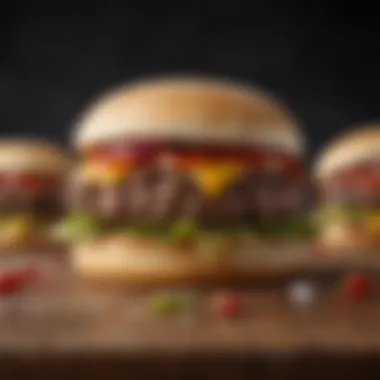

However, care needs to be taken. Patties that are too thick may end up raw inside, while those too thin can dry out quickly.
Handling Techniques
Handling techniques refer to how the meat is manipulated during patty formation. Gentle handling is crucial when working with the meat. Overworking the meat can lead to a denser texture which can ruin the burger's intended pleasure.
An example of a beneficial practice is using the palm of your hands to easily shape the patties, applying minimal pressure. Moreover, making a slight indent in the center of the patty helps with even cooking. This prevents the patty from puffing up, which can lead to uneven cooking.
Advantages of mastering proper handling techniques include:
- Enhanced texture.
- More even cooking.
- Maintaining juices inside the patty.
In summary, size and thickness, along with handling techniques, directly informs the cooking process and the end result of the burger. Failing to account for these factors can lead to a meal that does not satisfy, supporting the notion that preparation is as important as cooking itself.
Marinating: When and How
Marinating is an optional yet powerful method to infuse flavors into hamburger patties. The process involves using a mixture of seasoning and acid to tenderize the meat and add moisture, which can affect both texture and taste. Appropriate marinating can produce especially savory and tender results.
Consider marinating directly before cooking. The optimal timeframe is around 30 minutes to 2 hours. This allows the meat to pick up the flavors without breaking down too much. The acid, typically from vinegar or citrus, works to tenderize and change flavor profiles making it much more interesting.
One should exercise caution with the amounts; over-marinating can lead to undesirable moistness. A well-balanced marination can elevate a burger from basic to exemplary. Selecting the right liquids and spices reflects personal taste, and creativity with marinades can truly make each cooking session unique.
Proper preparation influnces not only cooking time, but defines the final taste and consistency of the beef burger. Careful attention to patty size, handling, and optional marinating techniques will amplify the burger realizing delicious outcomes.
Cooking Methods
Cooking methods are crucial to achieving the perfect beef burger. Each method contributes unique flavors and textures by influencing how the meat cooks. Various techniques like grilling, pan-frying, baking, and sous vide offer different outcomes. Mastering these methods ensures a delicious end product, enhancing the overall burger experience.
Grilling
Grilling is one of the most iconic methods for cookings burgers, often associated with outdoor gatherings. It imparts a distinct smoky flavor that many find appealing.
Gas vs.
Charcoal Grills
The ongoing debate between gas and charcoal grilling is prevalent among culinary enthusiasts. gas grills allow for quick temperature adjustments, and they can heat up faster. This convenience often appeals to busy individuals wanting to prepare their meals efficiently. In contrast, charcoal grills provide a more traditional approach. They offer a rich, smoky flavor that can be hard to replicate with gas.
Both types present unique benefits. The gas grillwins in convenience, while charcoal excels in flavor. Depending on your preference, you can select which offers the experiences you desire.
Grilling Times and Temperatures
Understanding specific grilling times and temperatures is integral to improving your burger's success. Cooking burgers to the right internal temperature ensures they are safe to eat and optimally juicy. Many recommend cooking beef burgers to at least 160°F for health standards.
Temperatures can also slightly vary by thickness and personal preferences for doneness. Monitoring the internal temp with a meat thermometer is a proven method for achieving desired results.
Pan-Frying
Pan-frying offers its own array of techniques for cooking burgers. This method sometimes creates an excellent crisp, adding texture while ensuring a well-cooked burger.
Choosing the Right Pan
The type of pan you choose significantly influences quality. Cast iron is a favored option due to its heat retention capability, which can create a beautiful sear on the patty. Non-stick pans are popular for easy cleanup, but they might not yield the same depth of flavor.
Overall, a robust pan makes a difference in how the heat distributes and contributes to a desired sear and crust.
Cooking Techniques
Different techniques can be applied while cooking burgers in a pan. Users can reverse sear or sear first and then lower the heat. Both allow for various adjustments. Regardless of the path taken, the burger remains juicy through direct heat cooking, along with fat rendered during the frying process.
Baking Burgers
Baking offers convenience without needing constant supervision. Setting a timer and temperature allows individuals to multitask. Some enjoy wrapping burgers in parchment paper to maintain moisture while cooking. It creates a different texture, one that offers simplicity and a delightful crust.
Sous Vide Technique
Sous vide is an innovative cooking technique that ensures precision in cooking beef burgers. By immersing patties in water, you can regulate the temperature accurately. This method guarantees even cooking throughout the meat while preserving its juices. Moreover, it allows continuous experimentation with different flavor profiles by adding spices and marinades throughout the process.
Using sous vide then finishing in a hot pan or grill effectively combines the benefits of various cooking methods. This hybrid technique is a highly regarded choice for cooking burgers perfectly every time. With so many options to choose from, it remains essential to select a cooking method that meets your taste and utilities.
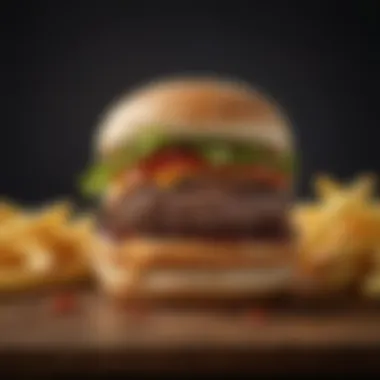
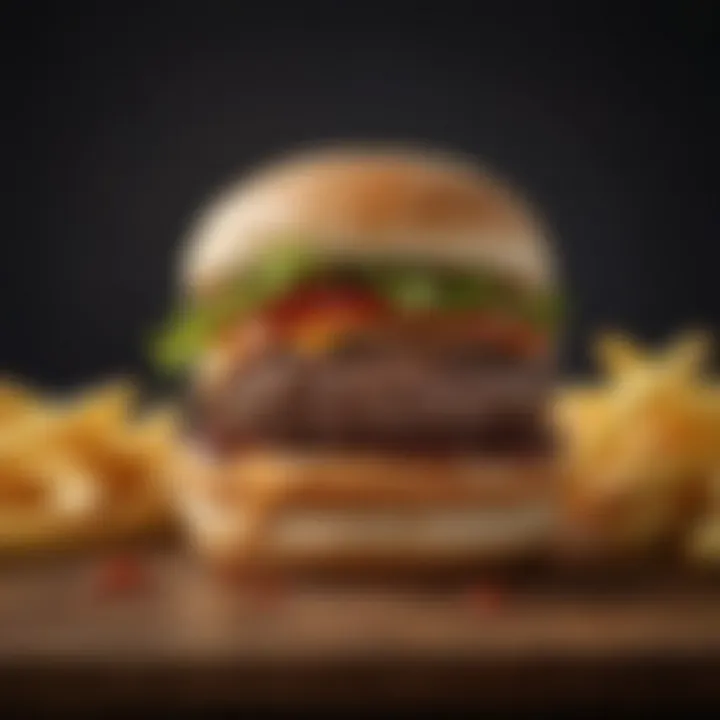
Assembling the Burger
The final step in creating the perfect beef burger is crucial: assembling the burger. This process can significantly impact the flavor and overall experience of tasting a burger. Each layer serves a purpose, contributing to texture, taste, and presentation. To ensure that every bite is a delight, it is necessary to focus on how each element should pair and complement each other.
Layering for Flavor
When it comes to layering a burger, the order in which ingredients are assembled is not just a matter of preference; there are distinct reasons for each layer's position. Placing sauces directly underneath the burger patty can not only moisten the patty but also help in keeping the bun's integrity. Additionally, incorporating lettuce at the bottom creates a barrier that prevents the bun from becoming soggy.
Here is a structured way to assemble your burger for optimal flavor:
- Bottom Bun: Start with a toasted bottom bun for stability.
- Leafy Greens: Add fresh lettuce to provide crunch and prevent sogginess.
- Tomato Slices: Layer fresh tomatoes for juiciness and acidity.
- Onions: Optional but diminish sweetness; can be raw, grilled, or pickled.
- Burger Patty: Center your patty securely; this is the main star.
- Cheese: If you add cheese, let it melt on the patty while cooking—for additional flavor.
- Toppings: Consider adding special ingredients last; this makes it easier to customize.
- Top Bun: Finally, cap it with a light or toasted top bun.
Following a consistent layering method not only elevates taste but also ensures the burger maintains structural integrity as you take a bite.
Presentation Tips
The visual appeal of a burger can significantly enhance the dining experience. Some effective presentation tips can elevate the meal even before the first bite. Here are some points to consider:
- Wrap the Bun: Consider wrapping the burger in parchment paper. This has practical benefits and presents a polished look.
- Serve with Style: Use attractive serving platters. Wooden boards can offer a rustic charm.
- Use Color: Incorporate colorful toppings. Ingredients like beetroot, avocados, or unique condiments bring vibrancy.
- Arrange Sides Thoughtfully: Position fries or side salads artfully nearby. A separate small bowl for sauces minimizes mess.
- Height Matters: Aim for a tall burger where possible, as this adds to the visuals. Layering ingredients effectively helps achieve this height.
- Garnish: Don’t ignore garnishes. Fresh herbs or edible flowers may enhance presentation.
Overall, assembling the burger requires thoughtful coordination between flavors and aesthetics. By taking the time to arrange each component carefully, a cook can enhance not just the flavor profile but the overall enjoyment of the beef burger.
Accompaniments
Accompaniments play a vital role in the overall enjoyment of beef burgers. They enhance the dining experience, providing variety and balancing the rich flavors of the burger itself. Effective pairing not only complements the main dish but also elevates it, contributing to both taste and visual appeal. Engaging side dishes and sauces can make a simple meal memorable.
Side Dishes
Fries and Chips
Fries and chips are a classic choice that complements beef burgers well. They have a crispy texture that contrasts with the juicy meat, providing a satisfying crunch. A common belief is that fries are an essential pairing for burgers, and this idea is well-founded. The way they absorb the oils and seasonings can lead to fascinating flavor dynamics.
Advantages of fries include convenience, with many ready-made options available that can be easily prepared parallel to cooking burgers. Their occurrences in menus showcase popularity. However, deep frying them can be seen as a drawback in terms of health.
Salads
Salads add freshness and a much-needed balance to beef burgers, cutting through the richness of the meat. They can be both hearty and light depending on the ingredients used. Popular options include coleslaw or garden salads, which can partake a contrasting crunch of textures.
Benefits include the ability to customize according to flavor preferences and dietary restrictions. Salads can introduce flavors from herbs and vinaigrettes that compliment burgers. However, the taste might not excite some burger enthusiasts because of the mildness compared to meaty flavors.
Cooking Sauces
Homemade vs.
Store-bought
The discussion of homemade vs. store-bought sauces remains relevant when crafting a delicious burger experience. Store-bought sauces offer users convenience and time-saving options. They provide familiar flavors quick and easy. However, making sauces at home allows for control over ingredients and freedom to modify recipes according to personal preference.
Homemade sauces can enhance the burger with unique styles, valuable flavors and higher quality ingredients. Some may find it challenging or time-consuming to make them from scratch; this sometimes becomes a trade-off.
Types of Sauces
Sauces come in various types, adding layers of flavor to beef burgers and transforming a simple dish into something distinctive. Classic ketchup and mustard are standard, but one can delve into tangy barbecue sauces or spicy aioli to match different tastes. Selecting the right kind can enhance the overall palate and even contrast beautifully with the burger itself.
Each type has a unique feature: for instance, barbecue sauce often offers a smoky sweetness, while aioli adds creaminess and depth. Some advantages of switching sauces point towards variety and the exploration of global cuisine. Nevertheless, overusing sauces can overpower delicate seasoning of the burger itself. Select carefully.
The End
The conclusion of this article underscores the significance of mastering beef burgers, a staple of varied culinary traditions. Understanding the process of creating the perfect burger is not just about cooking; it involves choosing right ingredients, applying precise techniques, and appreciating the overall experience of dining. Each step outlined— from selecting premium beef to experimenting with garnishes— reflects a meticulous blend of ingredients and practicality that resonates with culinary enthusiasts.
Recap of Key Points
Throughout the guide, various aspects have been covered, emphasizing not just the art of cooking, but also the science of flavor pairing. Some key takeaways include:
- Selecting the Right Beef: Different cuts of beef bring unique flavors, and understanding fat content is essential for optimum juiciness.
- Preparation Techniques: Proper formation of patties and the value of marinating highlight important steps.
- Cooking Methods: Multiple methods such as grilling, pan-frying, or sous vide offer diverse avenues for preparation, allowing for adaptability based on personal preference.
- Assembly: Layering ingredients thoughtfully ensures that each bite delivers on flavor.
- Accompaniments: The right sides and sauces complement burgers, enhancing the meal significantly.
Mastering these aspects not only simplifies the cooking process but also elevates the flavor profile.
Encouragement for Experimentation
Culinary creativity is an essential facet of developing your burger-making skills. Exploring new combinations, experimenting with cooking times, and venturing beyond the classic toppings can broaden your culinary repertoire. Consider:
- Alternative Proteins: Blending other meats or plant substitutes can add unique twists.
- Varied Toppings: Unique flavors can come from caramelized vegetables to unexpected sauces, like aioli or sriracha.
- Cultural Flairs: Incorporating international elements can yield exciting results. Explore spices or condiments from different cuisines to refresh your approach.
Every cook has the potential to advance the traditional beef burger concept. Embrace the idea of reinvention for an ultimate beef burger that resonates uniquely to your taste. Your journey into experimentation may reveal as many new flavors as it does discoveries about taste itself.







